Blog & Latest Updates
Fly Fishing Articles
Insects by Common Name


Updates from January 13, 2004
Videos by Troutnut from the Namekagon River and the Marengo River in Wisconsin
Dragonfly Nymph Scooting Around
Starring: Gomphidae Dragonfly Nymph
Dragonfly nymphs propel themselves through the water with a miniature jet engine, taking water in below their mouths and shooting it out their back ends. You can see the ripples from the jet out this one's back in this video.
StateWisconsin
LocationNamekagon River
Date ShotJan 13, 2004
Date AddedMar 31, 2006
AuthorTroutnut
CameraOlympus C740UZ
Ephemera 1
Starring: Ephemera simulans Mayfly Nymph
StateWisconsin
LocationNamekagon River
Date ShotJan 13, 2004
Date AddedMar 31, 2006
AuthorTroutnut
CameraOlympus C740UZ
Ephemera 2
Starring: Ephemera simulans Mayfly Nymph
This little Ephemera nymph swam around for a while and tried to burrow into the sand in my photography tank.
StateWisconsin
LocationMarengo River
Date ShotJan 13, 2004
Date AddedMar 31, 2006
AuthorTroutnut
CameraOlympus C740UZ
Closeup insects by Troutnut from the Namekagon River in Wisconsin
Pteronarcys dorsata (Giant Black Stonefly) Stonefly Nymph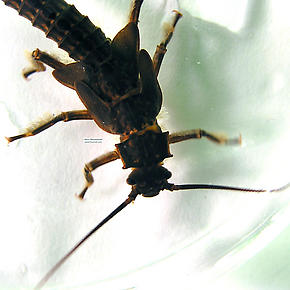 View 7 Pictures
View 7 Pictures
 View 7 Pictures
View 7 PicturesCollected January 13, 2004 from the Namekagon River in Wisconsin
Added to Troutnut.com by Troutnut on January 25, 2006
Added to Troutnut.com by Troutnut on January 25, 2006
Leptophlebia cupida (Borcher Drake) Mayfly Nymph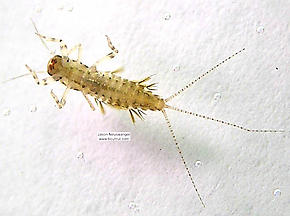 View 7 Pictures
View 7 Pictures
 View 7 Pictures
View 7 PicturesCollected January 13, 2004 from the Namekagon River in Wisconsin
Added to Troutnut.com by Troutnut on January 25, 2006
Added to Troutnut.com by Troutnut on January 25, 2006
Isonychia bicolor (Mahogany Dun) Mayfly Nymph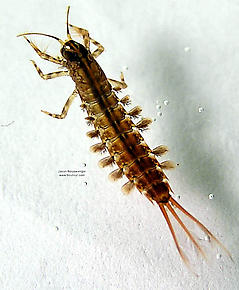 View 5 Pictures
View 5 Pictures
 View 5 Pictures
View 5 PicturesCollected January 13, 2004 from the Namekagon River in Wisconsin
Added to Troutnut.com by Troutnut on January 25, 2006
Added to Troutnut.com by Troutnut on January 25, 2006
Ephemerella invaria (Sulphur Dun) Mayfly Nymph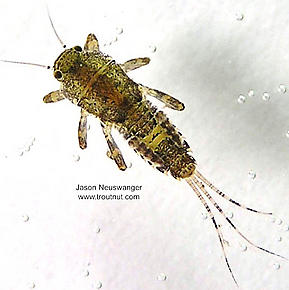 View 5 Pictures
View 5 Pictures
 View 5 Pictures
View 5 PicturesCollected January 13, 2004 from the Namekagon River in Wisconsin
Added to Troutnut.com by Troutnut on January 25, 2006
Added to Troutnut.com by Troutnut on January 25, 2006
Ephemerellidae (Hendricksons, Sulphurs, PMDs, BWOs) Mayfly Nymph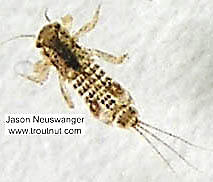 View 5 Pictures
View 5 Pictures
 View 5 Pictures
View 5 PicturesCollected January 13, 2004 from the Namekagon River in Wisconsin
Added to Troutnut.com by Troutnut on January 25, 2006
Added to Troutnut.com by Troutnut on January 25, 2006
Cordulegaster Dragonfly Nymph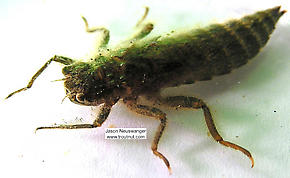 View 4 PicturesThis is a realy big, dark dragonfly nymph. Notice how "fuzzy" it is--it's covered with small hairs that collect sediment and debris and camouflage the nymph to match its natural surroundings. The greenish cast in some of the photos of this specimen is due to strange lighting during my first night photographing things for this site.
View 4 PicturesThis is a realy big, dark dragonfly nymph. Notice how "fuzzy" it is--it's covered with small hairs that collect sediment and debris and camouflage the nymph to match its natural surroundings. The greenish cast in some of the photos of this specimen is due to strange lighting during my first night photographing things for this site.
 View 4 PicturesThis is a realy big, dark dragonfly nymph. Notice how "fuzzy" it is--it's covered with small hairs that collect sediment and debris and camouflage the nymph to match its natural surroundings. The greenish cast in some of the photos of this specimen is due to strange lighting during my first night photographing things for this site.
View 4 PicturesThis is a realy big, dark dragonfly nymph. Notice how "fuzzy" it is--it's covered with small hairs that collect sediment and debris and camouflage the nymph to match its natural surroundings. The greenish cast in some of the photos of this specimen is due to strange lighting during my first night photographing things for this site.Collected January 13, 2004 from the Namekagon River in Wisconsin
Added to Troutnut.com by Troutnut on January 25, 2006
Added to Troutnut.com by Troutnut on January 25, 2006
Nigronia serricornis (Fishfly) Hellgrammite Larva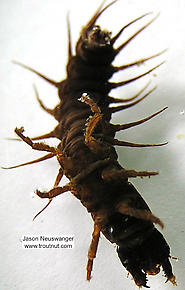 View 4 Pictures
View 4 Pictures
 View 4 Pictures
View 4 PicturesCollected January 13, 2004 from the Namekagon River in Wisconsin
Added to Troutnut.com by Troutnut on January 25, 2006
Added to Troutnut.com by Troutnut on January 25, 2006
Gomphidae Dragonfly Nymph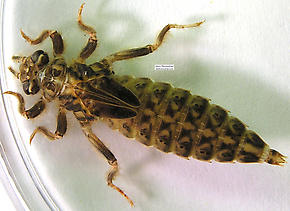 View 3 Pictures
View 3 Pictures
 View 3 Pictures
View 3 PicturesCollected January 13, 2004 from the Namekagon River in Wisconsin
Added to Troutnut.com by Troutnut on January 25, 2006
Added to Troutnut.com by Troutnut on January 25, 2006
Acroneuria lycorias (Golden Stone) Stonefly Nymph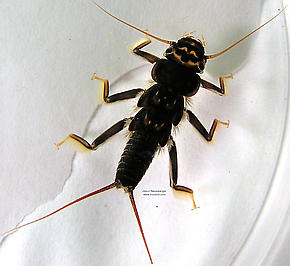 View 4 PicturesThe presence of anal gills, large dark spot in the center of the pale occipital bar point to lycorias.
View 4 PicturesThe presence of anal gills, large dark spot in the center of the pale occipital bar point to lycorias.
 View 4 PicturesThe presence of anal gills, large dark spot in the center of the pale occipital bar point to lycorias.
View 4 PicturesThe presence of anal gills, large dark spot in the center of the pale occipital bar point to lycorias.Collected January 13, 2004 from the Namekagon River in Wisconsin
Added to Troutnut.com by Troutnut on January 25, 2006
Added to Troutnut.com by Troutnut on January 25, 2006
Ephemerella subvaria (Hendrickson) Mayfly Nymph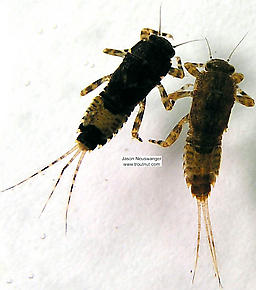 View 4 PicturesThese are two common color patterns on Hendrickson nymphs. I suspect that one is male and the other female, but I don't know for sure.
View 4 PicturesThese are two common color patterns on Hendrickson nymphs. I suspect that one is male and the other female, but I don't know for sure.
 View 4 PicturesThese are two common color patterns on Hendrickson nymphs. I suspect that one is male and the other female, but I don't know for sure.
View 4 PicturesThese are two common color patterns on Hendrickson nymphs. I suspect that one is male and the other female, but I don't know for sure.Collected January 13, 2004 from the Namekagon River in Wisconsin
Added to Troutnut.com by Troutnut on January 25, 2006
Added to Troutnut.com by Troutnut on January 25, 2006
Belostoma flumineum (Electric Light Bug) Giant Water Bug Adult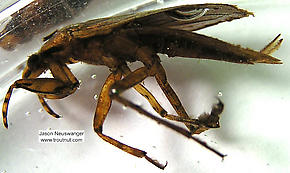 View 4 PicturesI haven't seen the imitation of these things stressed, but in August 2003 on one of my favorite rivers the largest brown trout I kept had stomachs full of these things.
View 4 PicturesI haven't seen the imitation of these things stressed, but in August 2003 on one of my favorite rivers the largest brown trout I kept had stomachs full of these things.
 View 4 PicturesI haven't seen the imitation of these things stressed, but in August 2003 on one of my favorite rivers the largest brown trout I kept had stomachs full of these things.
View 4 PicturesI haven't seen the imitation of these things stressed, but in August 2003 on one of my favorite rivers the largest brown trout I kept had stomachs full of these things.Collected January 13, 2004 from the Namekagon River in Wisconsin
Added to Troutnut.com by Troutnut on January 25, 2006
Added to Troutnut.com by Troutnut on January 25, 2006
Cottidae (Sculpins) Sculpin Adult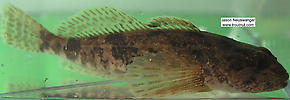 View 4 PicturesMottled Sculpin
View 4 PicturesMottled Sculpin
Cottus bairdi
 View 4 PicturesMottled Sculpin
View 4 PicturesMottled SculpinCottus bairdi
Collected January 13, 2004 from the Namekagon River in Wisconsin
Added to Troutnut.com by Troutnut on January 25, 2006
Added to Troutnut.com by Troutnut on January 25, 2006
Ephemerella subvaria (Hendrickson) Mayfly Nymph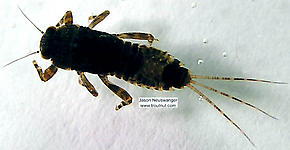 View 4 Pictures
View 4 Pictures
 View 4 Pictures
View 4 PicturesCollected January 13, 2004 from the Namekagon River in Wisconsin
Added to Troutnut.com by Troutnut on January 25, 2006
Added to Troutnut.com by Troutnut on January 25, 2006
Ephemerella invaria (Sulphur Dun) Mayfly Nymph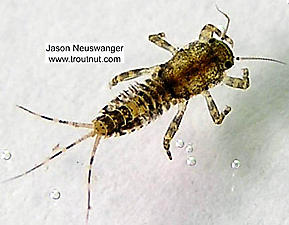 View 4 Pictures
View 4 Pictures
 View 4 Pictures
View 4 PicturesCollected January 13, 2004 from the Namekagon River in Wisconsin
Added to Troutnut.com by Troutnut on January 25, 2006
Added to Troutnut.com by Troutnut on January 25, 2006
Baetisca laurentina (Armored Mayfly) Mayfly Nymph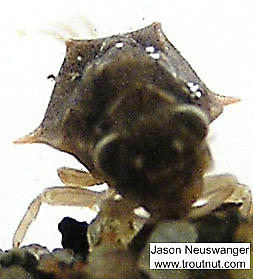 View 4 Pictures
View 4 Pictures
 View 4 Pictures
View 4 PicturesCollected January 13, 2004 from the Namekagon River in Wisconsin
Added to Troutnut.com by Troutnut on January 25, 2006
Added to Troutnut.com by Troutnut on January 25, 2006
Baetidae (Blue-Winged Olives) Mayfly Nymph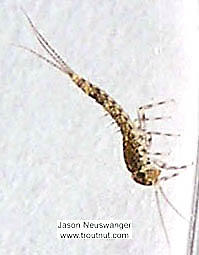 View 4 Pictures
View 4 Pictures
 View 4 Pictures
View 4 PicturesCollected January 13, 2004 from the Namekagon River in Wisconsin
Added to Troutnut.com by Troutnut on January 25, 2006
Added to Troutnut.com by Troutnut on January 25, 2006
Ephemerella invaria (Sulphur Dun) Mayfly Nymph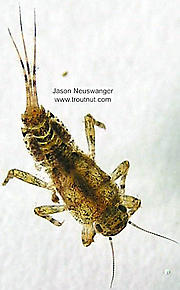 View 4 Pictures
View 4 Pictures
 View 4 Pictures
View 4 PicturesCollected January 13, 2004 from the Namekagon River in Wisconsin
Added to Troutnut.com by Troutnut on January 25, 2006
Added to Troutnut.com by Troutnut on January 25, 2006
Male Caecidotea (Cress Bugs) Sowbug Adult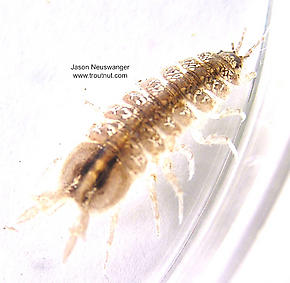 View 3 Pictures
View 3 Pictures
 View 3 Pictures
View 3 PicturesCollected January 13, 2004 from the Namekagon River in Wisconsin
Added to Troutnut.com by Troutnut on January 25, 2006
Added to Troutnut.com by Troutnut on January 25, 2006
Gasterosteidae (Sticklebacks) Stickleback Adult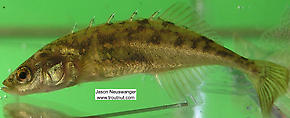 View 3 PicturesBrook Stickleback
View 3 PicturesBrook Stickleback
Culea inconstans
 View 3 PicturesBrook Stickleback
View 3 PicturesBrook SticklebackCulea inconstans
Collected January 13, 2004 from the Namekagon River in Wisconsin
Added to Troutnut.com by Troutnut on January 25, 2006
Added to Troutnut.com by Troutnut on January 25, 2006
Ephemerella (Hendricksons, Sulphurs, PMDs) Mayfly Nymph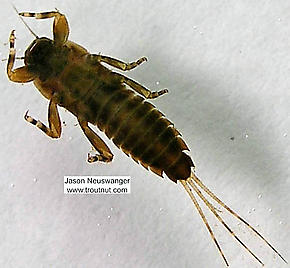 View 3 PicturesMorphologically this one looks a lot like subvaria but the color is really different.
View 3 PicturesMorphologically this one looks a lot like subvaria but the color is really different.
 View 3 PicturesMorphologically this one looks a lot like subvaria but the color is really different.
View 3 PicturesMorphologically this one looks a lot like subvaria but the color is really different.Collected January 13, 2004 from the Namekagon River in Wisconsin
Added to Troutnut.com by Troutnut on January 25, 2006
Added to Troutnut.com by Troutnut on January 25, 2006
Acroneuria lycorias (Golden Stone) Stonefly Nymph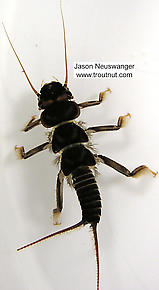 View 3 Pictures
View 3 Pictures
 View 3 Pictures
View 3 PicturesCollected January 13, 2004 from the Namekagon River in Wisconsin
Added to Troutnut.com by Troutnut on January 25, 2006
Added to Troutnut.com by Troutnut on January 25, 2006
Tipulidae (Crane Flies) Crane Fly Larva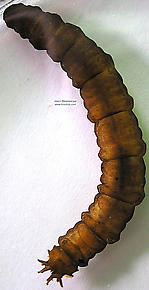 View 3 Pictures
View 3 Pictures
 View 3 Pictures
View 3 PicturesCollected January 13, 2004 from the Namekagon River in Wisconsin
Added to Troutnut.com by Troutnut on January 25, 2006
Added to Troutnut.com by Troutnut on January 25, 2006
Maccaffertium vicarium (March Brown) Mayfly Nymph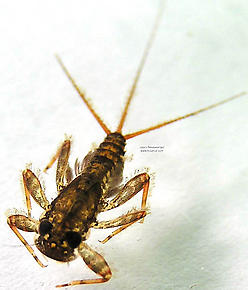 View 3 Pictures
View 3 Pictures
 View 3 Pictures
View 3 PicturesCollected January 13, 2004 from the Namekagon River in Wisconsin
Added to Troutnut.com by Troutnut on January 25, 2006
Added to Troutnut.com by Troutnut on January 25, 2006
Gasterosteidae (Sticklebacks) Stickleback Adult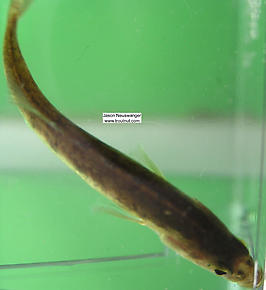 View 3 PicturesBrook Stickleback
View 3 PicturesBrook Stickleback
Culea inconstans
 View 3 PicturesBrook Stickleback
View 3 PicturesBrook SticklebackCulea inconstans
Collected January 13, 2004 from the Namekagon River in Wisconsin
Added to Troutnut.com by Troutnut on January 25, 2006
Added to Troutnut.com by Troutnut on January 25, 2006
Maccaffertium modestum (Cream Cahill) Mayfly Nymph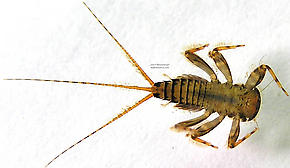 View 3 Pictures
View 3 Pictures
 View 3 Pictures
View 3 PicturesCollected January 13, 2004 from the Namekagon River in Wisconsin
Added to Troutnut.com by Troutnut on January 25, 2006
Added to Troutnut.com by Troutnut on January 25, 2006
Isonychia (Slate Drakes) Mayfly Nymph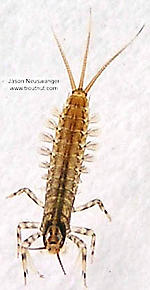 View 3 PicturesThis smaller Isonychia nymph was caught with a bunch of bicolor specimens, but it does not have the fluffy spine structure at the base of its gills. This might mean it's Isonychia sayi, or it might just be a bicolor nymph too young to have developed those structures.
View 3 PicturesThis smaller Isonychia nymph was caught with a bunch of bicolor specimens, but it does not have the fluffy spine structure at the base of its gills. This might mean it's Isonychia sayi, or it might just be a bicolor nymph too young to have developed those structures.
 View 3 PicturesThis smaller Isonychia nymph was caught with a bunch of bicolor specimens, but it does not have the fluffy spine structure at the base of its gills. This might mean it's Isonychia sayi, or it might just be a bicolor nymph too young to have developed those structures.
View 3 PicturesThis smaller Isonychia nymph was caught with a bunch of bicolor specimens, but it does not have the fluffy spine structure at the base of its gills. This might mean it's Isonychia sayi, or it might just be a bicolor nymph too young to have developed those structures.Collected January 13, 2004 from the Namekagon River in Wisconsin
Added to Troutnut.com by Troutnut on January 25, 2006
Added to Troutnut.com by Troutnut on January 25, 2006
Leucrocuta hebe (Little Yellow Quill) Mayfly Nymph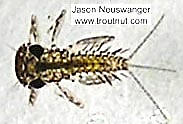 View 4 PicturesThis is a very early instar (Instar: Many invertebrates molt through dozens of progressively larger and better-developed stages as they grow. Each of these stages is known as an instar. Hard-bodied nymphs typically molt through more instars than soft-bodied larvae.).
View 4 PicturesThis is a very early instar (Instar: Many invertebrates molt through dozens of progressively larger and better-developed stages as they grow. Each of these stages is known as an instar. Hard-bodied nymphs typically molt through more instars than soft-bodied larvae.).
 View 4 PicturesThis is a very early instar (Instar: Many invertebrates molt through dozens of progressively larger and better-developed stages as they grow. Each of these stages is known as an instar. Hard-bodied nymphs typically molt through more instars than soft-bodied larvae.).
View 4 PicturesThis is a very early instar (Instar: Many invertebrates molt through dozens of progressively larger and better-developed stages as they grow. Each of these stages is known as an instar. Hard-bodied nymphs typically molt through more instars than soft-bodied larvae.).Collected January 13, 2004 from the Namekagon River in Wisconsin
Added to Troutnut.com by Troutnut on January 25, 2006
Added to Troutnut.com by Troutnut on January 25, 2006
Baetidae (Blue-Winged Olives) Mayfly Nymph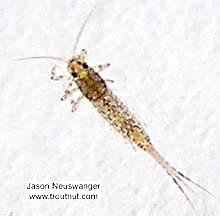 View 3 Pictures
View 3 Pictures
 View 3 Pictures
View 3 PicturesCollected January 13, 2004 from the Namekagon River in Wisconsin
Added to Troutnut.com by Troutnut on January 25, 2006
Added to Troutnut.com by Troutnut on January 25, 2006
Ephemerella invaria (Sulphur Dun) Mayfly Nymph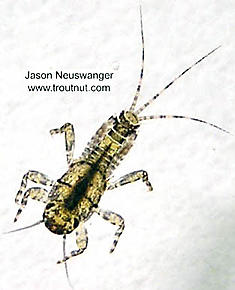 View 3 Pictures
View 3 Pictures
 View 3 Pictures
View 3 PicturesCollected January 13, 2004 from the Namekagon River in Wisconsin
Added to Troutnut.com by Troutnut on January 25, 2006
Added to Troutnut.com by Troutnut on January 25, 2006
Ephemerellidae (Hendricksons, Sulphurs, PMDs, BWOs) Mayfly Nymph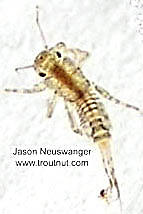 View 3 Pictures
View 3 Pictures
 View 3 Pictures
View 3 PicturesCollected January 13, 2004 from the Namekagon River in Wisconsin
Added to Troutnut.com by Troutnut on January 25, 2006
Added to Troutnut.com by Troutnut on January 25, 2006
Baetisca laurentina (Armored Mayfly) Mayfly Nymph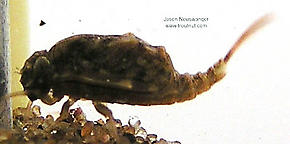 View 3 Pictures
View 3 Pictures
 View 3 Pictures
View 3 PicturesCollected January 13, 2004 from the Namekagon River in Wisconsin
Added to Troutnut.com by Troutnut on January 25, 2006
Added to Troutnut.com by Troutnut on January 25, 2006
Epeorus vitreus (Sulphur) Mayfly Nymph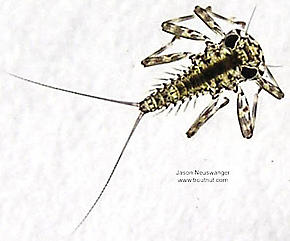 View 3 PicturesI suspect this is an Epeorus vitreus nymph. At the current instar (Instar: Many invertebrates molt through dozens of progressively larger and better-developed stages as they grow. Each of these stages is known as an instar. Hard-bodied nymphs typically molt through more instars than soft-bodied larvae.), it's tough to make out the pair of dots on the tergites (
View 3 PicturesI suspect this is an Epeorus vitreus nymph. At the current instar (Instar: Many invertebrates molt through dozens of progressively larger and better-developed stages as they grow. Each of these stages is known as an instar. Hard-bodied nymphs typically molt through more instars than soft-bodied larvae.), it's tough to make out the pair of dots on the tergites (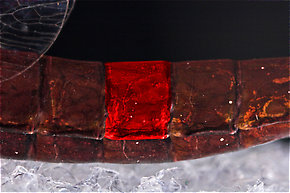 Tergite: The top (dorsal) part of a single segment on an insect's abdomen when it consists of a single chitinous plate (sclerite), or an individual sclerite if the segment has more than one.) which signify that species, but with zooming and contrast enhancement they become evident.
Tergite: The top (dorsal) part of a single segment on an insect's abdomen when it consists of a single chitinous plate (sclerite), or an individual sclerite if the segment has more than one.) which signify that species, but with zooming and contrast enhancement they become evident.
 View 3 PicturesI suspect this is an Epeorus vitreus nymph. At the current instar (Instar: Many invertebrates molt through dozens of progressively larger and better-developed stages as they grow. Each of these stages is known as an instar. Hard-bodied nymphs typically molt through more instars than soft-bodied larvae.), it's tough to make out the pair of dots on the tergites (
View 3 PicturesI suspect this is an Epeorus vitreus nymph. At the current instar (Instar: Many invertebrates molt through dozens of progressively larger and better-developed stages as they grow. Each of these stages is known as an instar. Hard-bodied nymphs typically molt through more instars than soft-bodied larvae.), it's tough to make out the pair of dots on the tergites (
One tergite of this Isonychia bicolor mayfly spinner is highlighted in red.
Collected January 13, 2004 from the Namekagon River in Wisconsin
Added to Troutnut.com by Troutnut on January 25, 2006
Added to Troutnut.com by Troutnut on January 25, 2006
Ephemerella invaria (Sulphur Dun) Mayfly Nymph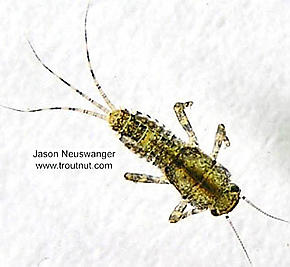 View 3 Pictures
View 3 Pictures
 View 3 Pictures
View 3 PicturesCollected January 13, 2004 from the Namekagon River in Wisconsin
Added to Troutnut.com by Troutnut on January 25, 2006
Added to Troutnut.com by Troutnut on January 25, 2006
Maccaffertium (March Browns and Cahills) Mayfly Nymph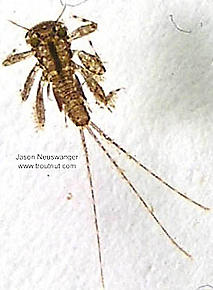 View 3 Pictures
View 3 Pictures
 View 3 Pictures
View 3 PicturesCollected January 13, 2004 from the Namekagon River in Wisconsin
Added to Troutnut.com by Troutnut on January 25, 2006
Added to Troutnut.com by Troutnut on January 25, 2006
Maccaffertium (March Browns and Cahills) Mayfly Nymph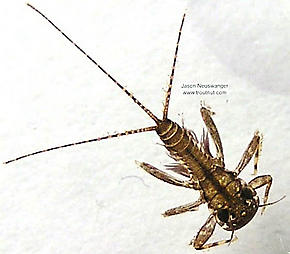 View 3 Pictures
View 3 Pictures
 View 3 Pictures
View 3 PicturesCollected January 13, 2004 from the Namekagon River in Wisconsin
Added to Troutnut.com by Troutnut on January 25, 2006
Added to Troutnut.com by Troutnut on January 25, 2006
Maccaffertium (March Browns and Cahills) Mayfly Nymph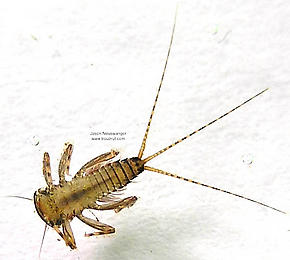 View 3 Pictures
View 3 Pictures
 View 3 Pictures
View 3 PicturesCollected January 13, 2004 from the Namekagon River in Wisconsin
Added to Troutnut.com by Troutnut on January 25, 2006
Added to Troutnut.com by Troutnut on January 25, 2006
Ephemerella invaria (Sulphur Dun) Mayfly Nymph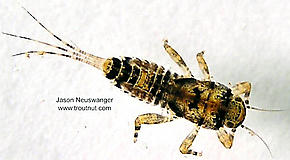 View 3 Pictures
View 3 Pictures
 View 3 Pictures
View 3 PicturesCollected January 13, 2004 from the Namekagon River in Wisconsin
Added to Troutnut.com by Troutnut on January 25, 2006
Added to Troutnut.com by Troutnut on January 25, 2006
Maccaffertium (March Browns and Cahills) Mayfly Nymph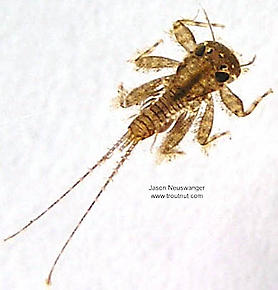 View 3 Pictures
View 3 Pictures
 View 3 Pictures
View 3 PicturesCollected January 13, 2004 from the Namekagon River in Wisconsin
Added to Troutnut.com by Troutnut on January 25, 2006
Added to Troutnut.com by Troutnut on January 25, 2006
Capniidae (Snowflies) Stonefly Nymph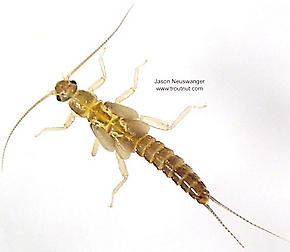 View 3 Pictures
View 3 Pictures
 View 3 Pictures
View 3 PicturesCollected January 13, 2004 from the Namekagon River in Wisconsin
Added to Troutnut.com by Troutnut on January 25, 2006
Added to Troutnut.com by Troutnut on January 25, 2006
Ephemerella invaria (Sulphur Dun) Mayfly Nymph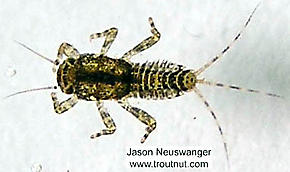 View 3 Pictures
View 3 Pictures
 View 3 Pictures
View 3 PicturesCollected January 13, 2004 from the Namekagon River in Wisconsin
Added to Troutnut.com by Troutnut on January 25, 2006
Added to Troutnut.com by Troutnut on January 25, 2006
Ephemerellidae (Hendricksons, Sulphurs, PMDs, BWOs) Mayfly Nymph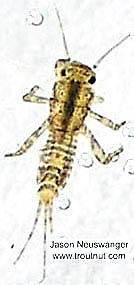 View 3 Pictures
View 3 Pictures
 View 3 Pictures
View 3 PicturesCollected January 13, 2004 from the Namekagon River in Wisconsin
Added to Troutnut.com by Troutnut on January 25, 2006
Added to Troutnut.com by Troutnut on January 25, 2006
Ephemerella invaria (Sulphur Dun) Mayfly Nymph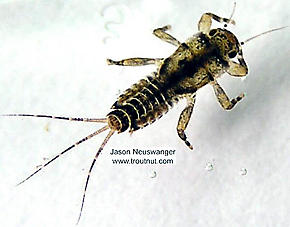 View 3 Pictures
View 3 Pictures
 View 3 Pictures
View 3 PicturesCollected January 13, 2004 from the Namekagon River in Wisconsin
Added to Troutnut.com by Troutnut on January 25, 2006
Added to Troutnut.com by Troutnut on January 25, 2006
Ephemerella invaria (Sulphur Dun) Mayfly Nymph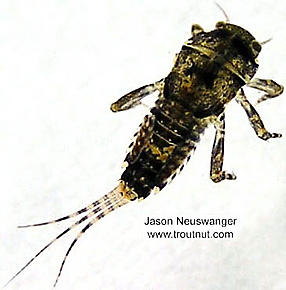 View 3 Pictures
View 3 Pictures
 View 3 Pictures
View 3 PicturesCollected January 13, 2004 from the Namekagon River in Wisconsin
Added to Troutnut.com by Troutnut on January 25, 2006
Added to Troutnut.com by Troutnut on January 25, 2006
Baetidae (Blue-Winged Olives) Mayfly Nymph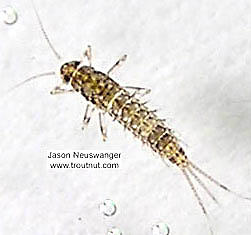 View 3 Pictures
View 3 Pictures
 View 3 Pictures
View 3 PicturesCollected January 13, 2004 from the Namekagon River in Wisconsin
Added to Troutnut.com by Troutnut on January 25, 2006
Added to Troutnut.com by Troutnut on January 25, 2006
Baetidae (Blue-Winged Olives) Mayfly Nymph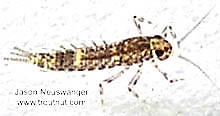 View 3 PicturesThis one's tails are chopped off and it's missing a leg.
View 3 PicturesThis one's tails are chopped off and it's missing a leg.
 View 3 PicturesThis one's tails are chopped off and it's missing a leg.
View 3 PicturesThis one's tails are chopped off and it's missing a leg.Collected January 13, 2004 from the Namekagon River in Wisconsin
Added to Troutnut.com by Troutnut on January 25, 2006
Added to Troutnut.com by Troutnut on January 25, 2006
Ephemerella invaria (Sulphur Dun) Mayfly Nymph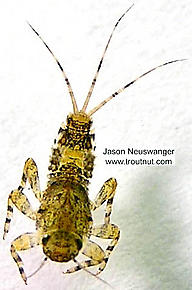 View 3 Pictures
View 3 Pictures
 View 3 Pictures
View 3 PicturesCollected January 13, 2004 from the Namekagon River in Wisconsin
Added to Troutnut.com by Troutnut on January 25, 2006
Added to Troutnut.com by Troutnut on January 25, 2006
Ephemerella invaria (Sulphur Dun) Mayfly Nymph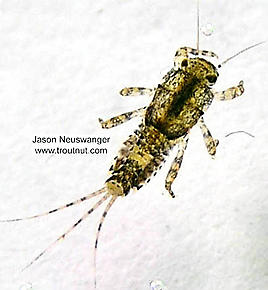 View 3 Pictures
View 3 Pictures
 View 3 Pictures
View 3 PicturesCollected January 13, 2004 from the Namekagon River in Wisconsin
Added to Troutnut.com by Troutnut on January 25, 2006
Added to Troutnut.com by Troutnut on January 25, 2006
Ephemerella (Hendricksons, Sulphurs, PMDs) Mayfly Nymph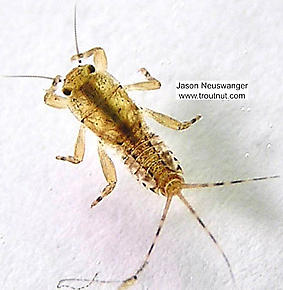 View 3 Pictures
View 3 Pictures
 View 3 Pictures
View 3 PicturesCollected January 13, 2004 from the Namekagon River in Wisconsin
Added to Troutnut.com by Troutnut on January 25, 2006
Added to Troutnut.com by Troutnut on January 25, 2006
Baetidae (Blue-Winged Olives) Mayfly Nymph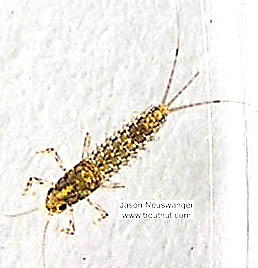 View 3 Pictures
View 3 Pictures
 View 3 Pictures
View 3 PicturesCollected January 13, 2004 from the Namekagon River in Wisconsin
Added to Troutnut.com by Troutnut on January 25, 2006
Added to Troutnut.com by Troutnut on January 25, 2006
Cambaridae Crayfish Juvenile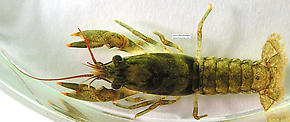 View 2 Pictures
View 2 Pictures
 View 2 Pictures
View 2 PicturesCollected January 13, 2004 from the Namekagon River in Wisconsin
Added to Troutnut.com by Troutnut on January 25, 2006
Added to Troutnut.com by Troutnut on January 25, 2006
Hydrophilidae (Giant Water Scavenger Beetles) Beetle Adult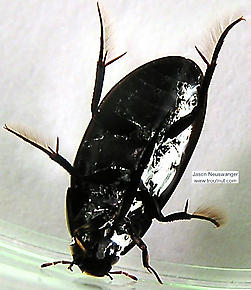 View 2 PicturesThis is a water beetle. It is the hardest object in the world to pick up with tweezers. The second hardest is Mount Everest.
View 2 PicturesThis is a water beetle. It is the hardest object in the world to pick up with tweezers. The second hardest is Mount Everest.
 View 2 PicturesThis is a water beetle. It is the hardest object in the world to pick up with tweezers. The second hardest is Mount Everest.
View 2 PicturesThis is a water beetle. It is the hardest object in the world to pick up with tweezers. The second hardest is Mount Everest.Collected January 13, 2004 from the Namekagon River in Wisconsin
Added to Troutnut.com by Troutnut on January 25, 2006
Added to Troutnut.com by Troutnut on January 25, 2006
Amphipoda (Scuds) Scud Adult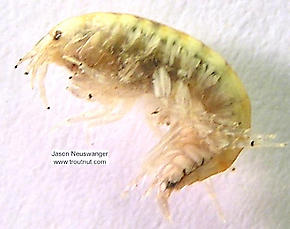 View 2 Pictures
View 2 Pictures
 View 2 Pictures
View 2 PicturesCollected January 13, 2004 from the Namekagon River in Wisconsin
Added to Troutnut.com by Troutnut on January 25, 2006
Added to Troutnut.com by Troutnut on January 25, 2006
Gomphidae Dragonfly Nymph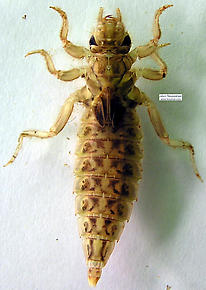 View 2 Pictures
View 2 Pictures
 View 2 Pictures
View 2 PicturesCollected January 13, 2004 from the Namekagon River in Wisconsin
Added to Troutnut.com by Troutnut on January 25, 2006
Added to Troutnut.com by Troutnut on January 25, 2006
Leucrocuta hebe (Little Yellow Quill) Mayfly Nymph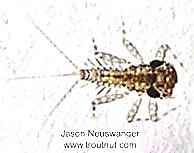 View 2 PicturesThis is a very early instar (Instar: Many invertebrates molt through dozens of progressively larger and better-developed stages as they grow. Each of these stages is known as an instar. Hard-bodied nymphs typically molt through more instars than soft-bodied larvae.).
View 2 PicturesThis is a very early instar (Instar: Many invertebrates molt through dozens of progressively larger and better-developed stages as they grow. Each of these stages is known as an instar. Hard-bodied nymphs typically molt through more instars than soft-bodied larvae.).
 View 2 PicturesThis is a very early instar (Instar: Many invertebrates molt through dozens of progressively larger and better-developed stages as they grow. Each of these stages is known as an instar. Hard-bodied nymphs typically molt through more instars than soft-bodied larvae.).
View 2 PicturesThis is a very early instar (Instar: Many invertebrates molt through dozens of progressively larger and better-developed stages as they grow. Each of these stages is known as an instar. Hard-bodied nymphs typically molt through more instars than soft-bodied larvae.).Collected January 13, 2004 from the Namekagon River in Wisconsin
Added to Troutnut.com by Troutnut on January 25, 2006
Added to Troutnut.com by Troutnut on January 25, 2006
Taeniopteryx (Early Black Stoneflies) Stonefly Nymph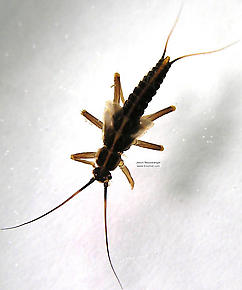 View 2 Pictures
View 2 Pictures
 View 2 Pictures
View 2 PicturesCollected January 13, 2004 from the Namekagon River in Wisconsin
Added to Troutnut.com by Troutnut on January 25, 2006
Added to Troutnut.com by Troutnut on January 25, 2006
Ephemerella invaria (Sulphur Dun) Mayfly Nymph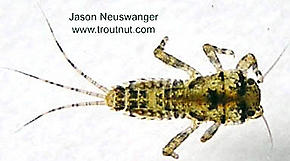 View 2 Pictures
View 2 Pictures
 View 2 Pictures
View 2 PicturesCollected January 13, 2004 from the Namekagon River in Wisconsin
Added to Troutnut.com by Troutnut on January 25, 2006
Added to Troutnut.com by Troutnut on January 25, 2006
Baetidae (Blue-Winged Olives) Mayfly Nymph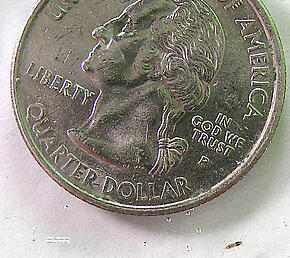 View 2 Pictures
View 2 Pictures
 View 2 Pictures
View 2 PicturesCollected January 13, 2004 from the Namekagon River in Wisconsin
Added to Troutnut.com by Troutnut on January 25, 2006
Added to Troutnut.com by Troutnut on January 25, 2006
Ephemerella invaria (Sulphur Dun) Mayfly Nymph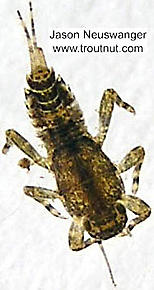 View 2 Pictures
View 2 Pictures
 View 2 Pictures
View 2 PicturesCollected January 13, 2004 from the Namekagon River in Wisconsin
Added to Troutnut.com by Troutnut on January 25, 2006
Added to Troutnut.com by Troutnut on January 25, 2006
Ephemerella invaria (Sulphur Dun) Mayfly Nymph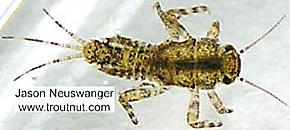 View 2 Pictures
View 2 Pictures
 View 2 Pictures
View 2 PicturesCollected January 13, 2004 from the Namekagon River in Wisconsin
Added to Troutnut.com by Troutnut on January 25, 2006
Added to Troutnut.com by Troutnut on January 25, 2006
Ephemerella invaria (Sulphur Dun) Mayfly Nymph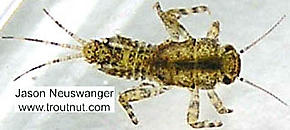 View 2 Pictures
View 2 Pictures
 View 2 Pictures
View 2 PicturesCollected January 13, 2004 from the Namekagon River in Wisconsin
Added to Troutnut.com by Troutnut on January 25, 2006
Added to Troutnut.com by Troutnut on January 25, 2006
Maccaffertium (March Browns and Cahills) Mayfly Nymph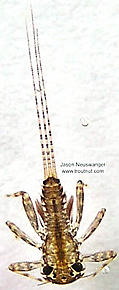 View 2 Pictures
View 2 Pictures
 View 2 Pictures
View 2 PicturesCollected January 13, 2004 from the Namekagon River in Wisconsin
Added to Troutnut.com by Troutnut on January 25, 2006
Added to Troutnut.com by Troutnut on January 25, 2006
Ephemerella invaria (Sulphur Dun) Mayfly Nymph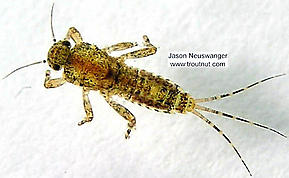 View 2 Pictures
View 2 Pictures
 View 2 Pictures
View 2 PicturesCollected January 13, 2004 from the Namekagon River in Wisconsin
Added to Troutnut.com by Troutnut on January 25, 2006
Added to Troutnut.com by Troutnut on January 25, 2006
Ephemerella invaria (Sulphur Dun) Mayfly Nymph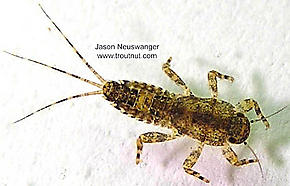 View 2 Pictures
View 2 Pictures
 View 2 Pictures
View 2 PicturesCollected January 13, 2004 from the Namekagon River in Wisconsin
Added to Troutnut.com by Troutnut on January 25, 2006
Added to Troutnut.com by Troutnut on January 25, 2006
Cottidae (Sculpins) Sculpin Adult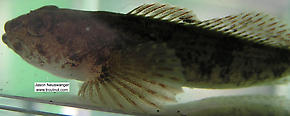 View 1 PicturesMottled Sculpin
View 1 PicturesMottled Sculpin
Cottus bairdi
 View 1 PicturesMottled Sculpin
View 1 PicturesMottled SculpinCottus bairdi
Collected January 13, 2004 from the Namekagon River in Wisconsin
Added to Troutnut.com by Troutnut on January 25, 2006
Added to Troutnut.com by Troutnut on January 25, 2006
Percidae (Perch, Walleyes, and Darters) Fish Adult View 1 PicturesJohnny Darter (Etheostoma nigrum)
View 1 PicturesJohnny Darter (Etheostoma nigrum)
 View 1 PicturesJohnny Darter (Etheostoma nigrum)
View 1 PicturesJohnny Darter (Etheostoma nigrum)Collected January 13, 2004 from the Namekagon River in Wisconsin
Added to Troutnut.com by Troutnut on January 25, 2006
Added to Troutnut.com by Troutnut on January 25, 2006
Most recent comments on this post (latest on top)
Comment on this post
Top 10 Fly Hatches
Top Gift Shop Designs
Eat mayflies.
Top Insect Specimens
Miscellaneous Sites
Troutnut.com is copyright © 2004-2024 Jason
Neuswanger (email Jason). See my FAQ for information about use of my images.
 privacy policy
privacy policy
